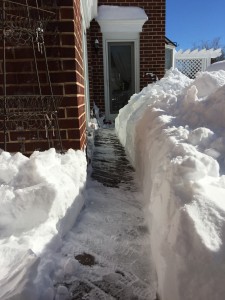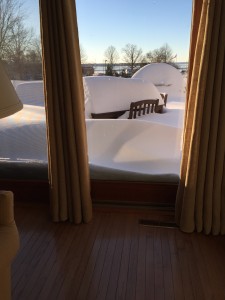
Opening the drapery and finding more than 30 inches of snow from winter storm Jonas. It was beautiful, but paralyzed the Washington region for a week!
We dodged a big one this week and are getting rain instead, but lately we have been using a four-letter word a little too much — SNOW! And a three-letter word, too — ICE!
Winter storms can really do some damage, and it didn’t surprise me that winter storm “Jonas” left some nasty damage in his wake a few weeks ago. I’ve got some ways to fix some of the worst damage, and ways to prevent damage in the future, as well as some interesting snow clearing tips for my readers. Hope you don’t have to use them anytime soon, but here they are just in case.
When you have really deep snow and drifts, it’s important to give first priority to clearing away the snow from your doors, and shovel a pathway out just in case you need to get out in an emergency.
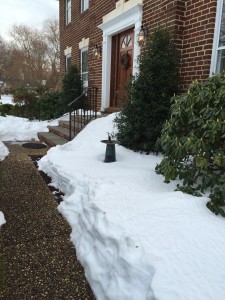
Spreading a plastic tarp on your porch and stairs before a snowstorm makes it easy to clear off. I cleared this in about one minute!
Here’s my favorite new tip that I just tried out on my front porch. It is so easy to do, and I bet it saved an hour of shoveling! Before a snow storm, just spread out a plastic tarp over your stairs and porch leaving a foot or two of extra length at your door. Weigh down the edges with bricks or large rocks to keep it from blowing away. When the storm is over, slowly lift the tarp from both sides. It is like teflon — the snow simply slides off leaving a clean and dry porch and stairs underneath. I wish I had known this trick years ago; what a time saver!
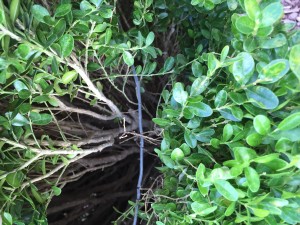
If you spiral (every 6 inches or so) a string or wire loosely from the base of a plant all the way up to the top, you can help the small branches from splitting open and breaking under the weight of the snow. Especially prone to splitting are boxwood and arborvitae.
I get lots of questions about snow pack on plants, and whether or not to remove it. In most cases my best advice is to leave it alone, and let it melt away naturally. Most plants have an amazing ability of springing back to normal all by themselves, but there are some tips I want to share which help them stay strong in the face of heavy snow pack. Starting from the base of a plant, loosely spiral some string or wire up through the branches to the top of the plant. I like to use this black plastic coated wire because it disappears into the branches, and is virtually invisible. This will help the plant to hold together and not split open under the weight of the snow. If you have extremely heavy wet snow you can very carefully lift it off with a spading fork or your hands. But, if the snow is frozen to the branches, it is best to leave it alone, it can easily tear the branches off.

Here’s an example of how much spiraling a wire through the boxwood can help. The one on the right has it, and the one next to it doesn’t. Makes all the difference!
Be mindful not to toss heavy shovels full of snow onto your plants when you are clearing your walkways and drives. It can be so heavy that it crushes the plants under the weight of the snow. If you have any broken branches, cut them off as soon as you can safely do so. To leave the broken/torn branches attached could cause disease to set in. Try to remember which plants those were and give them a really good pruning in the early spring to prevent damage in future winters.
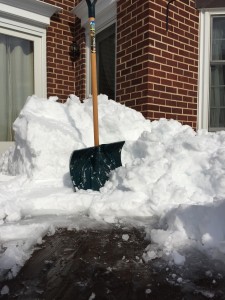
Deep snow is extremely heavy 7 to 20 pounds/sq. ft. Try to stand straight while shoveling, and lift with your legs.
We learned a lot from this deep snow, and can’t say this enough: work slowly, take lots of breaks, hydrate often, keep your back straight and lift with your legs. This is such heavy work, and it gives your heart a real workout! Be careful out there! And, as the groundhog predicted, spring will arrive soon… CAN’T WAIT!!!!

